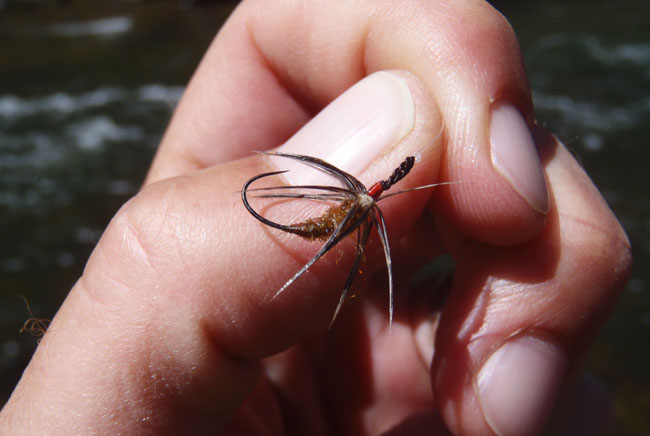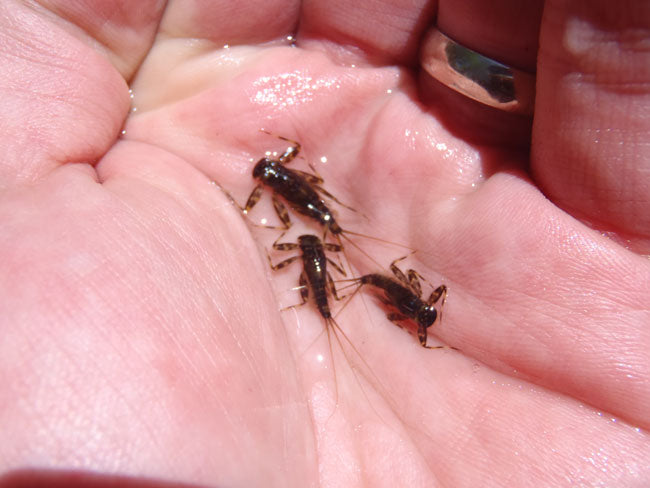Written by Jason
Where I grew up, knowing aquatic entomology was considered just as much of a necessary skill in fly fishing as casting. In fact, being able to identify insects (by their Latin names of course) was a sign of “stream cred” and if you could state the number of tails a nymph had on demand simply upon hearing it’s Latin name, you were instantly seen as an expert angler.
As a young fly fisher eager to gain stream cred, I took it upon myself to rise to the challenge. I read aquatic entomology books more studiously than anything I ever did in school. I collected stream samples and kept rows of vials containing carefully preserved bugs on my fly tying desk for reference. It resembled (what I imagined) the entomology department at some lofty university like Harvard. I could rattle off Latin names with the best of them, tell you when they’d hatch based on the number of days the water exceeded a certain temperature, and, of course, point out the differences between males and females. On the stream, I spent almost as much time lifting rocks and combing through spider webs to find insects as I did fishing.
Looking back, it reminds me of baseball. Baseball is a pretty simple game. Yet, it’s so encumbered by statistics that you almost have to be a mathematician to have an intelligent conversation about it. To me, that ruins the game somewhat. I didn’t know it at the time, but I was ruining my own game by being so preoccupied with entomology.
The belief that a good fly angler also had to be a good entomologist influenced my fly tying. I tied for every contingency. In the ten fly boxes that bogged my vest down (making every wade a potential suicide mission), I probably had patterns for not only every species of aquatic insect on the East coast, but also every stage of every species. Fly selection on the water became an algorithm, which is odd because I’ve always hated math. But I thought that was how it was supposed to be. After all, that’s what elevated fly fishing above cruder forms of fishing like bait fishing, right?
So there I was—a pretty competent amateur entomologist with a fly rod in my hands. I definitely got the stream cred. People would bring insects to the fly shop where I worked and ask me to identify them. It was certainly an ego boost, but there was just one problem. This knowledge wasn’t helping me catch fish. The fish didn’t seem to abide by the algorithm. Sometimes, they took flies when they “shouldn’t” have. And other times, perfectly realistic imitations presented perfectly didn’t catch a thing. What was going on? Why weren’t the fish playing by the rules?
It wasn’t until about ten years ago when I moved to Colorado that my perception about the importance of entomology in fly fishing began to shift. Back East, before you took your first cast, the common practice was to observe--see what’s going on to determine which fly to put on. Are the fish rising? If so, what kind of rise patterns? Get out the insect net and drag the bottom to see what’s drifting down. Look in the trees to see if there are any mayflies or in spider webs to see if they’ve trapped any caddis. There was a Sherlock Holmes mentality to approaching a stream and I wouldn’t even have thought of tying on a fly before conducting a thorough investigation.
But in Colorado, it was the opposite. I found the fish quite willing to take pretty much any fly I put in front of them. Part of this is due to the comparative lack of food in many of the high altitude streams I was fishing. When the fish have a limited menu, they have to be more opportunistic. I found that 90% of the time, I could walk up to a stream, tie on an Elk Hair Caddis, and catch fish (even when there were no caddis hatching). It was baffling, yet refreshing to not have to approach the stream like a crime scene.
Back then, I had never heard of tenkara and while I didn’t realize it at the time, life was hinting at the fact that while spouting off Latin names might make you a big shot in the fly shop, all the entomology in the world doesn’t necessarily help you catch fish in real life. I was slowly learning that I had always focused too much on the fly and not enough on the fishing. In retrospect, I realize that I was getting a taste of the philosophy behind the tenkara one fly approach.
In tenkara, emphasis is placed on presentation more than the actual fly. In fact, some go as far to say that the fly is irrelevant. This philosophy is what leads many tenkara anglers to adopt the so-called “one fly approach”. For some, this means randomly picking a pattern out of their fly box and only fishing that one for the day. For others, it literally means fishing only one fly pattern for their entire fishing career.

I'd rather just tie one of these on and fish!
Since discovering tenkara, I have mostly abandoned my entomological endeavors. Every once in a while I’ll still lift a rock or strain the water with my tamo, but it’s more for simple curiosity than academic knowledge. Which insects are hatching when never figures into my strategy anymore. I pick a fly to fish for the day and that’s it. I focus more on presentation than fly selection. The angler I was 10 years ago would be shocked to learn that I catch just as many (if not more) fish than I did by counting tails on duns and gills on nymphs.
Is entomology irrelevant then? I wouldn’t go that far. It would still benefit an angler to have some basic understanding of what’s on the fishes’ menu. But you don’t have to be a gourmet chef. For the novice, I think one of the great benefits of tenkara is that it removes this barrier to entry that many new fly anglers find so intimidating. Most people would rather just catch fish than have their noses buried in entomology books. And for the experienced angler, tenkara frees them up from becoming preoccupied with the trivia of insects and lets them spend more time doing what they’re on the stream to do: fish.
Tenkara has taught me that rather than an erudite scientific study, fly fishing can be a simpler, more primal dance between angler and trout. It pulls fly fishing back from its over-academicization and returns it to a more pristine state—one that doesn’t require an advanced degree to partake in. Which reminds me…does anyone want to buy some used entomology books?
